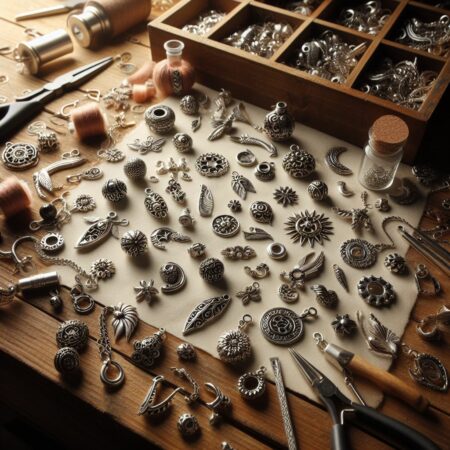This special feature on retro fashion aesthetic is brought to you by Xinar. Xinar has been selling jewelry-making supplies like genuine copper beads and findings for over twenty years. We also happen to have the most awesome collections of vintage and modern discontinued jewelry from Far Fetched Imports.
Styles that are either imitated or altered from previous eras are known as retro fashion, initially used in the 1970s. These trends include the retro fashion aesthetic. Designers in London first used the term “retro” to describe their aesthetic, and it quickly spread to the rest of the fashion industry. Fashion in retrograde or retrogression became synonymous with the prefix “backward.” While the term retro was new in the fashion context, the concept of born-again fashion had already been around for a long time.
The Retro Fashion Aesthetic Has Always Been Relative
The past has frequently served as a source of inspiration for fashion. For example, the French style of the 1790s, known as the Directoire, significantly influenced Paul Poiret’s 1910s designs, incorporating Egyptian and Greco-Roman elements.
Greek democracy and the Roman Republic were referenced in Neoclassicism in the 1790s, while later Egyptian symbols were used to remember Napoleon’s conquest of Egypt. Despite its emphasis on physical liberty, Poiret’s Neoclassicism appears to have had no political relevance. Influenced by the second Napoleonic Empire in the 1930s, French surrealist fashion was affected by this time (1852-1870).
As a result of World War II’s military uniforms, the New Look by Christian Dior emerged in 1947. A break from his mother’s fin de siècle finery, his wasp-waisted, hip-padded full-skirted form was an homage to his mother’s postwar austerity.
Designers like Azzedine Alaia, Claude Montana, Thierry Mugler, and Christian Lacroix, who all grew up in the Dior oeuvre, used Dior’s fitted jacked as a blueprint throughout the 1970s and 1980s. To some extent, the 1950s were a return to pre-World War II gender stereotypes and Cold War social conservatism with the emergence of full, petticoated skirts.
1960s fashion, like the 1920s, had youthful and anarchic energy, but it came from London’s streets rather than Paris’ salons. The 1960s may have been revived more than any other decade due to the Youthquake and the mini. This is especially evident when designers debut thigh-high miniskirts. Learn more about fashion from these decades .
Designers in their forties are reviving the 1970s, mainly the mid-1970s, which were nostalgic for the 1930s as the twenty-first century unfolds. Designers in their thirties first revisited the shoulder-padded 1980s, which owe a lot to the 1940s.
Designers born in the 1990s will be able to review the less-is-more aesthetic of the previous decade. They tend to be motivated by the period when they first became fascinated with fashion, usually in their adolescence or early twenties. In part, this is since the designers of the 1960s were legends whose work was documented, cataloged, and exhibited in museums as possibly no other until that time.
Retro Fashion Aesthetic in a Bigger Cultural and Historical Arc
When it comes to 1990s music, movies, and fashion, the term “retro” was coined to describe trends that used iconic or kitsch references to the past. “Retrochic” was a Paris avant-garde term coined in the late 1960s to tell the usage of revival or period styles from some examples of alternative consumerism. Contrary to popular belief, the term “nostalgia industry” was coined to describe the burgeoning business of the retro-chic movement.
Postmodern nostalgia and a humorous sense of nostalgia characterize the retro style. Instead of relying on the past for inspiration, the 1990s revivalism was characterized by careless and eclectic contempt. With no regard for sentimentality or discrimination, designs and styles were adopted without regard for nostalgia or prejudice. Designs like cribbage charms just prove that the past never stays in the past.
A pastiche, retro emphasized the stylish and cool features of “pastness” rather than historical context. Consequently, retro can be characterized as transforming historical narratives into nostalgic tales of the fashionable.
The term “retro” was coined to describe a particular era of fashion, music, and movies. While some styles have been labeled “retro” because of their resemblance to pop-cultural kitsch, more precise terms can be used to characterize them. When it comes to vintage clothes, the difference between vintage and retro styles is one of the historical era, loosely dividing pre-war and post-sixties fashion; retro is generally linked with the 1960s, 1970s, and 1980s.
“Retro” was used in the music industry to describe music associated with a specific time or zeitgeist, such as Disco and New Wave, by radio stations, music journalists, and marketing managers. However, retro is more commonly linked with mainstream nostalgia for the 1970s and 1980s music kitsch, such as Abba and Duran Duran, than with the creative spirit of Britpop (Blur echoed the Kinks, Oasis imitated the Beatles). In the same way, films deemed “retro” because of their soundtrack have also been labeled thus. The 2000s saw the rise of retro fashion aesthetic and other related looks.
Re-inventing the Age-Old Through Retro Fashion Aesthetic
Early twenty-first century saw the emergence of a new fashion mishmash based on borrowing from previous eras, so retro, but with a twist of “newness.” In different art genres, the idea of taking elements of someone else’s work and either replicating it or mixing it and then claiming it as one’s own is prevalent. This practice is known as “appropriation” in the art world. It’s called “sampling” in the music industry. It’s sequels or “part twos” in the movies. As in food, the term “fusion” is used to describe it. Reference is another popular term for retro styles.
The old rendered “fresh” is unique about this fusion art style. Moon maidens of Parisian designer Andre Courrèges, for example, wore white patent-leather boots with their space-age ensembles. Likewise, high heels or combat boots were coupled with Courrèges’s A-line sweaters, while some of the minis were layered over evening dresses or worn with leggings in the fused versions.
Using the Original Concepts as a Reference
Until this day, some designers take inspiration from the past and copy it verbatim, down to the stitch and line. Some credit the originals. Nancy Reagan wore his gown to a Washington banquet on the night before Ronald Reagan was inaugurated, and Bill Blass, who died in 2004, wrote the following about the first lady in his book Bare Blass, edited by New York Times fashion critic Cathy Horyn: “In my black velvet dress, she looked stunning. St. Laurent-inspired, according to Women’s Wear. Which is exactly what happened.”
Today, appropriation is no longer merely permissible; it is now expected. The second reason is that only a few magazine editors are willing to take the risk of losing advertising space by accusing an advertising designer of stealing- whoops, appropriation. Not many fashion writers in the early 2000s media mix could tell a stolen design from a legitimate one.
Retro Boutiques Are Back
The craze for retro fashion aesthetic is one of the reasons retro fashions became so popular in the late twentieth and early twenty-first centuries. Several years of “less are more” fashion-led many women to seek solace at swap meets, thrift shops, and vintage boutiques where the old looked suddenly newer than the new.
It’s in fashion’s nature to eat from the past. So complaining about the resurgence of vintage clothing is akin to whining about chicken.
People have been making chicken dishes for millennia, even though there is a well-known recipe for poulet. Chicken is still the main ingredient, despite the addition of new seasonings. Similarly, a good, time-tested design that can be modified with new materials and new accessories has earned the reputation of a classic dress from any era. Put another way, all you have to do is adjust the formula to reflect current preferences.






